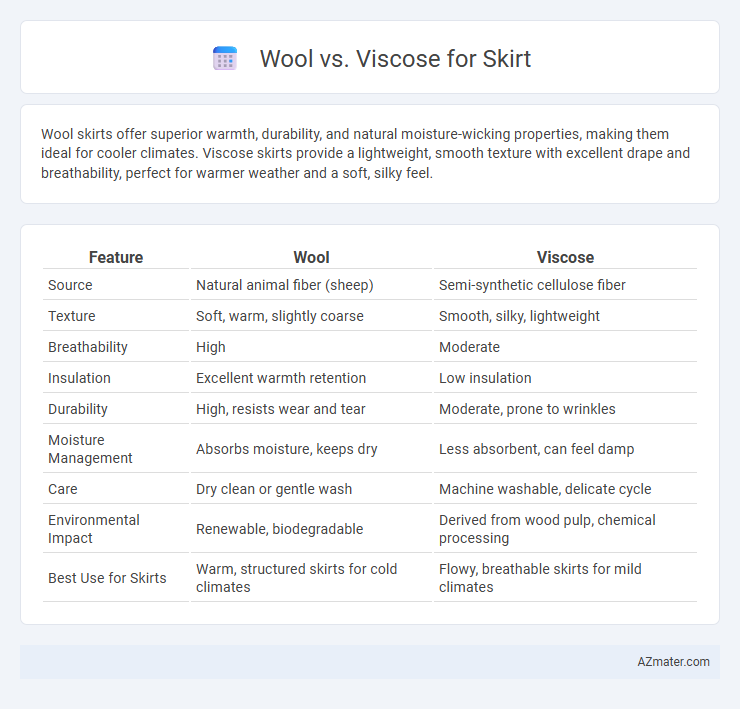Wool skirts offer superior warmth, durability, and natural moisture-wicking properties, making them ideal for cooler climates. Viscose skirts provide a lightweight, smooth texture with excellent drape and breathability, perfect for warmer weather and a soft, silky feel.
Table of Comparison
| Feature | Wool | Viscose |
|---|---|---|
| Source | Natural animal fiber (sheep) | Semi-synthetic cellulose fiber |
| Texture | Soft, warm, slightly coarse | Smooth, silky, lightweight |
| Breathability | High | Moderate |
| Insulation | Excellent warmth retention | Low insulation |
| Durability | High, resists wear and tear | Moderate, prone to wrinkles |
| Moisture Management | Absorbs moisture, keeps dry | Less absorbent, can feel damp |
| Care | Dry clean or gentle wash | Machine washable, delicate cycle |
| Environmental Impact | Renewable, biodegradable | Derived from wood pulp, chemical processing |
| Best Use for Skirts | Warm, structured skirts for cold climates | Flowy, breathable skirts for mild climates |
Introduction: Wool vs Viscose for Skirts
Wool and viscose are popular fabrics used in skirts, each offering distinct benefits. Wool provides excellent insulation, moisture-wicking properties, and durability, making it ideal for colder climates. Viscose, derived from natural fibers, offers a smooth, breathable texture with vibrant color retention, suitable for lightweight, flowy skirt designs.
Fiber Origins: Natural Wool and Manufactured Viscose
Natural wool fibers come from the fleece of sheep, offering excellent insulation, breathability, and moisture-wicking properties ideal for skirts in cooler climates. Manufactured viscose is derived from cellulose found in wood pulp, providing a smooth, lightweight fabric with a silky texture that drapes well for stylish, breathable skirts. Wool's renewable animal origin contrasts with viscose's semi-synthetic production, impacting durability, care needs, and environmental considerations in skirt design.
Texture and Comfort Comparison
Wool skirts offer a natural, warm texture that feels soft yet structured, providing excellent insulation for cooler weather. Viscose skirts feature a smooth, silky texture that drapes fluidly, enhancing comfort through breathability and moisture-wicking properties. The tactile contrast between wool's slightly coarse, cozy feel and viscose's lightweight, cool touch defines their comfort levels for different seasonal wear.
Breathability and Climate Suitability
Wool provides excellent breathability due to its natural fiber structure, making it ideal for colder climates as it regulates temperature and wicks moisture effectively. Viscose, being a semi-synthetic fabric derived from cellulose, offers moderate breathability but tends to retain heat and moisture, making it better suited for mild or warm weather. Choosing between wool and viscose skirts depends on the desired comfort level in varying climates, with wool favored for insulation and viscose for lighter, cooler wear.
Durability and Maintenance Needs
Wool skirts offer superior durability due to their natural resilience, resistance to wear, and ability to retain shape over time, making them ideal for long-term use. Viscose skirts require more careful maintenance as the fiber is prone to weakening when wet and may lose shape or develop pilling, demanding gentle washing and air drying. Choosing wool reduces the frequency of repairs and replacements, while viscose skirts need consistent delicate care to maintain fabric integrity.
Environmental Impact and Sustainability
Wool is a renewable, biodegradable fiber that boasts natural insulation and durability, contributing to lower environmental impact through its biodegradability and carbon sequestration properties. Viscose, derived from cellulose in wood pulp, often involves chemical-intensive processing and significant water use, raising concerns about deforestation and pollution unless sourced from certified sustainable forests. Choosing wool skirts supports sustainable practices when sourced from responsible farms, while viscose skirts require scrutiny of supply chains to ensure eco-friendly production and reduced environmental degradation.
Style and Appearance Differences
Wool skirts often showcase a textured, structured appearance with natural warmth, making them ideal for classic, tailored styles and winter wardrobes. Viscose skirts provide a smooth, silky drape and a lightweight feel, lending themselves to fluid, elegant silhouettes perfect for spring or summer wear. The natural matte finish of wool contrasts with viscose's subtle sheen, influencing the overall aesthetic and formality of the skirt design.
Cost Considerations: Wool vs Viscose
Wool skirts generally have a higher upfront cost due to the natural fiber's durability and insulating properties, making them a more expensive investment compared to viscose skirts. Viscose, a semi-synthetic fiber derived from cellulose, offers a more affordable price point but may require more frequent replacement due to lower durability. When factoring long-term wear and maintenance, wool skirts can provide better value despite the initial expense.
Ideal Occasions for Each Fabric
Wool skirts are ideal for cooler weather occasions such as office wear, formal events, and winter outings due to their warmth, durability, and classic texture. Viscose skirts suit warmer climates and casual to semi-formal events like brunches, summer parties, and daytime gatherings because of their lightweight, breathable fabric and smooth drape. Selecting wool provides insulating comfort and structure, while viscose offers elegance with a soft feel and moisture-wicking properties perfect for spring and summer.
Conclusion: Choosing the Best Fabric for Your Skirt
Wool offers superior warmth, durability, and natural breathability, making it ideal for skirts worn in cooler climates or formal settings. Viscose provides a lightweight, silky texture with excellent drape, suitable for vibrant, flowy skirts in warmer weather or casual wear. Choose wool for long-lasting insulation and structure, while viscose suits designs prioritizing softness and fluid movement.

Infographic: Wool vs Viscose for Skirt
 azmater.com
azmater.com